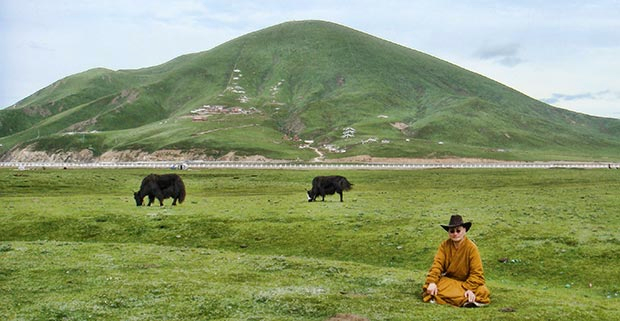A Sacred Mountain
The mountain which gives its name to Bayan (Wanyan) Monastery is also the dwelling place of Bayan Churi, a local god. With an elevation of over 14,000 feet, it's the highest mountain in the area. Bayan is known as a water mountain, and is notable for its great subterranean lakes, numerous productive springs that supply water to the monastery and nearby communities and ponds that contain amazing fish found nowhere else.
In springtime the mountain is covered by luxuriant, blue-green grasses. Bees are drawn by the lovely fragrance and bright colors of fields of wild flowers, and rare, prized medicinal herbs are abundant during the warmer months. When the deep winter finally settles in, the mountain is covered by a thick blanket of snow. At the foot of Bayan Mountain is the confluence of two great rivers: the long and placid Machu (Yellow) River, one of the largest rivers in the world; and the swift and sparkling Gyachu River.
With its many exceptional qualities, Bayan Mountain has long been considered a superb location for secluded monastic retreat. From ancient times, long before the monastery was first established in 1837, it was frequented by scholars and yogins.
Click to expand the images
The Monastery's Name
Bayan (Wanyan) Monastery's official name and its meaning: Bayan Sertang Gön Tennyi Dargye Ling
In English this is: The Monastery of Bayan (Wanyan) on the Golden Plain, from where the Two Teachings Spread and Flourish
The two teachings are (1) the verbal teachings of the Lord Buddha and his enlightened followers that are contained in the Buddhist canon, and (2) the realization of those teachings in the hearts of those who effectively practice them.
Two teachings also indicates the older translation tradition of the Nyingma-pa lineage, and the new translation traditions of the Geluk-pa, Sakya-pa, Kargyu-pa and other lineages. Bayan Monastery is a nonsectarian institution where all of these lineages are taught and practiced.
Bayan (Wanyan) Monastery
The monastery's beginnings and its history to its present time.

With Bayan Mountain rising in the distance, Sogan Rinpoche rests on a field during his 2007 return to Tibet. The buildings of Bayan Monastery are just visible high on the slopes behind him.
Bayan or Wanyan Monastery was established in the year of the Fire Bird (1837) by Do Khyentse Yeshe Dorje. Later, in 1866, Wangchen Gyerab Dorje, known as the Great Khenpo of Lab, established the three foundations of monastic training at Bayan Monastery. Amdo Geshe Jambel Rolway Dorje arrived in 1867, and Khewang Lozang Dongak (a.k.a Nyengon Sungrab Tulku), and many others came to Bayan Monastery soon after that, making it into a great center for the study and practice of the Lord Buddha’s Dharma. In 1868, the 5th Rabjam Rinpoche of Shechen Monastery, Nang Dze Drubpe Dorje, established the Mindroling tradition of the yearly ten-day intensive mantra meditation and accumulation practice known as the Tsebchu Drupchen, with its concluding two days of monastic sacred dances (‘chams).
Eventually, in 1936, the Omniscient 9th Panchen Lama, Tupten Chokyi Nyima, bestowed upon Bayan Monastery its official charter. From the founding master of Bayan Monastery, Do Khyentse Rinpoche, until 1959, the monastery has had a succession of thirty-seven abbots and twenty-five head professors, each supporting and teaching a non-sectarian (ris med) approach to the Buddha’s Dharma.
After 1959 Bayan Monastery was so thoroughly destroyed that not even a trace of it remained. It was not until the mid-1980's that the monastery began to rise again on the slopes of Mt. Bayan. At first, tents were erected on the site where buildings had once stood. A huge, cotton tent replaced the great assembly hall and smaller cotton and yak hair tents took the place of other buildings.
Several years later, Khenpo Munsel arrived and promoted the process of reestablishing the monastery by maintaining the ancient continuity of the lineage of vows and practices. Accordingly, he ordained novice and senior monks and reestablished the monastery as a center of Buddhist study and practice. From there he taught Dharma to many thousands of disciples, and gave empowerments such as Amitabha together with instructions and precepts for practice.
It was at this time that Khenpo Munsel, Sogan Rinpoche's root lama, gave him responsibility for the guidance and protection of Bayan Monastery, a position he retains to this day. This decision had the full support of the monks at Bayan who had known Sogan Rinpoche since his teenage years. They had long believed that he was a powerful tulku, but were not certain exactly who he was.
We are fortunate to share a book on The History of Bayan (Wanyan) Monastery. This edition is currently in Tibetan:

|
12.17印刷确定文件.pdf Size : 8495.374 Kb Type : pdf |
